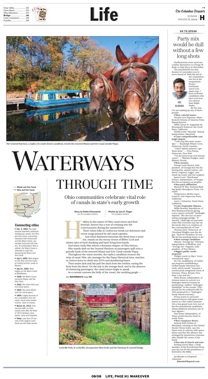Hidden in the names of Ohio canal towns and their festivals, history has a way of creeping into the consciousness during the summertime.
That's when folks in Coshocton break out dulcimers and croon songs penned by old canal captains.
And when Baltimore historian Jim Reed dons a straw hat, stands on the mossy stones of Bibler Lock and relates tales of hard-drinking and hard-living boat hands.
And when Andy Hite relives a dormant chapter of Ohio history.
Throughout the warm months, the replica canalboat retraces the strip of canal. Hite, site manager for the Piqua Historical Area, watches as visitors leave to climb into SUVs and shuddering buses.
Then mules Jack and Jim pull the slack from the towline, easing the boat from the shore. On the trip to the storage dock, and in the absence of chattering passengers, the canal waters begin to speak.
As a current caresses the belly of the vessel, the resulting gurgle -- gentle as a baby's laugh -- issues from below like a call from the past.
Hite balances on the boat's roof, gazing at concentric circles made as the bow slices reflections of sycamores. The setting can be eerily quiet.
"If I'm driving the mules or steering the boat and I'm by myself, I think: 'Who all's passed through here? And what were their aspirations when they did? What were they looking for?' "
If the ghosts that roam Hite's bit of canal could talk, they'd tell of pioneer ambition, high political stakes, necessary death, drunken brawls and whorehouses. They'd speak of a lost lifestyle in which babies were born on line boats and honeymooners traveled luxury packets.
The tales recall lives infinitely more simple -- and, therefore, immeasurably more difficult.
Today, Ohio canals exist only in remnants: scattered locks and occasional grooves where broad passageways formerly lay. Yet in the mid-1800s, canals cut across 1,000 miles of Ohio landscape, changing the face of the rugged frontier.
Before the state passed legislation to build canals in 1825, Cleveland -- still spelled Cleaveland -- was a collection of log cabins; Akron didn't exist. Ohioans traveled by foot or on wagon trails mired in mud. A trip from Columbus to Lake Erie took weeks.
"Ohio was in trouble," says Mary Ellen Given, director of marketing at Roscoe Village, a restored town on the Ohio and Erie Canal in Coshocton. "People were packing up -- going home. They couldn't sell their goods because they couldn't get them to market at a reasonable price."
The federal government refused to finance Ohio canals. State legislators built them anyway, selling bonds to pay the bill.
"Commissioners (appointed to oversee the project) paid out of their own pockets and then hoped the state would pay them back," says Norman Brown, a volunteer who leads tours in Piqua. "In many cases, it hurt their own businesses, their own finances."
In July 1825, laborers began hacking twin channels through the wilderness -- the Miami and Erie Canal in the west and the Ohio and Erie Canal in the east. At a ceremony in swampland near Newark, black flies gnawed at horses, whose snorting drowned out speeches by dignitaries.
The scene was a taste of hardship to come.
Many farmers won contracts to build half-mile sections near their property, but many underestimated costs and went bankrupt.
"You had sections completed next to sections not," Brown says. "It was a constant problem of money; there just wasn't enough money to give."
The work was dirty and grueling. Irish and German immigrants -- many of whom had trenched New York's Erie Canal -- dug for 30 cents a day and jiggers of whiskey.
Knee-deep in muck, the workers carved 40-foot-wide channels one shovelful at a time.
"If the shovel broke, the (jagged) end would just get (them) in the stomach," Brown says.
Clearing rock with black powder was dangerous and inexact. Laborers trying to cut a towpath from the face at Black Hand Gorge in Licking County blasted the famous formation to bits. Similar accidents claimed dozens of lives.
Even deadlier, though, was the "canal fever" that lurked in the camps where workers slept.
Millersport historian Ted Keller -- stepping through tombstones, blackened and buckled like old beggars' teeth -- looks over a 15-foot ledge into the Ohio and Erie, which wraps around the town cemetery like a giant "C."
"The sanitary conditions weren't necessarily the best in the world," he says.
Cholera, typhoid, smallpox and malaria took their toll.
The Deep Cut section near Millersport -- the final phase of the Ohio and Erie -- claimed more lives, money and resolve than any other section. The almost 2-mile stretch had to be lowered as much as 30 feet, to the level of the reservoir to the north.
Immigrants shoveled the hellish landscape for five years, until the Deep Cut was completed in 1831. Many ended up in the potter's field that became Millersport Cemetery.
Throughout the state, a third of canal workers -- roughly 1,000 -- perished.
"Wading in the muck, you get pneumonia easily," says Barnett Golding, a former officer of the Canal Society of Ohio, a nonprofit group that promotes the canal heritage.
"They just buried them along the way. No way to get them back to the next of kin. So they just put you in the embankment."
At great price, the frontier had been broken.
By 1850, hundreds of boats loaded with grain, salt pork and whiskey traveled the canals.
In a half-mile descent from Lockington, on the Miami and Erie north of Piqua, six locks spill down a green hillside like dominoes tipped from a box.
Andy Hite ambles across 500-pound slabs of limestone without minding the cavity into which he could tumble.
"A boat crew could technically navigate a lock in 15 minutes," he says. "With six locks, it wouldn't be inconceivable that you could spend a day in Lockington."
Businesses sprang up to meet the demands of canal users.
Several yards from Lock 1, a tidy brick house belies a licentious past. The Red Garter Inn, one historian explains with a wink, sold more than whiskey and lunch.
Warehouses, mills, dry-goods stores and boat makers soon lined the waterways.
Namesake towns emerged: Canal Fulton, Canal Winchester, Groveport, Lockington, Lockville, Lockbourne, Millersport.
Akron, plotted on the Ohio and Erie, burgeoned.
Cincinnati, Cleveland and Columbus boomed with trade.
That legacy survives.
Today, the culture of canals exists only in faded sepia photographs and in lyrics of canal songs.
Still, almost every Ohio canal town has a resident historian who brings the canals back to life.
Standing on the lip of a lock with Hite -- or Baltimore's Jim Reed or Millersport's Ted Keller -- one can almost hear the fights among boat hands trying to make it first through the locks, or the crack of blacksnake whips as barefoot boys drove mule teams.
The speed at which canal boats traveled -- 4 mph -- wasn't a lot.
"But put into the context of 1840 -- it was the speed the world moved at," Hite says. "This was great travel. You could walk to Cincinnati. But when you can ride . . ."
This article was published August 8, 2004, in the Columbus Dispatch.
Copyright Columbus Dispatch.




